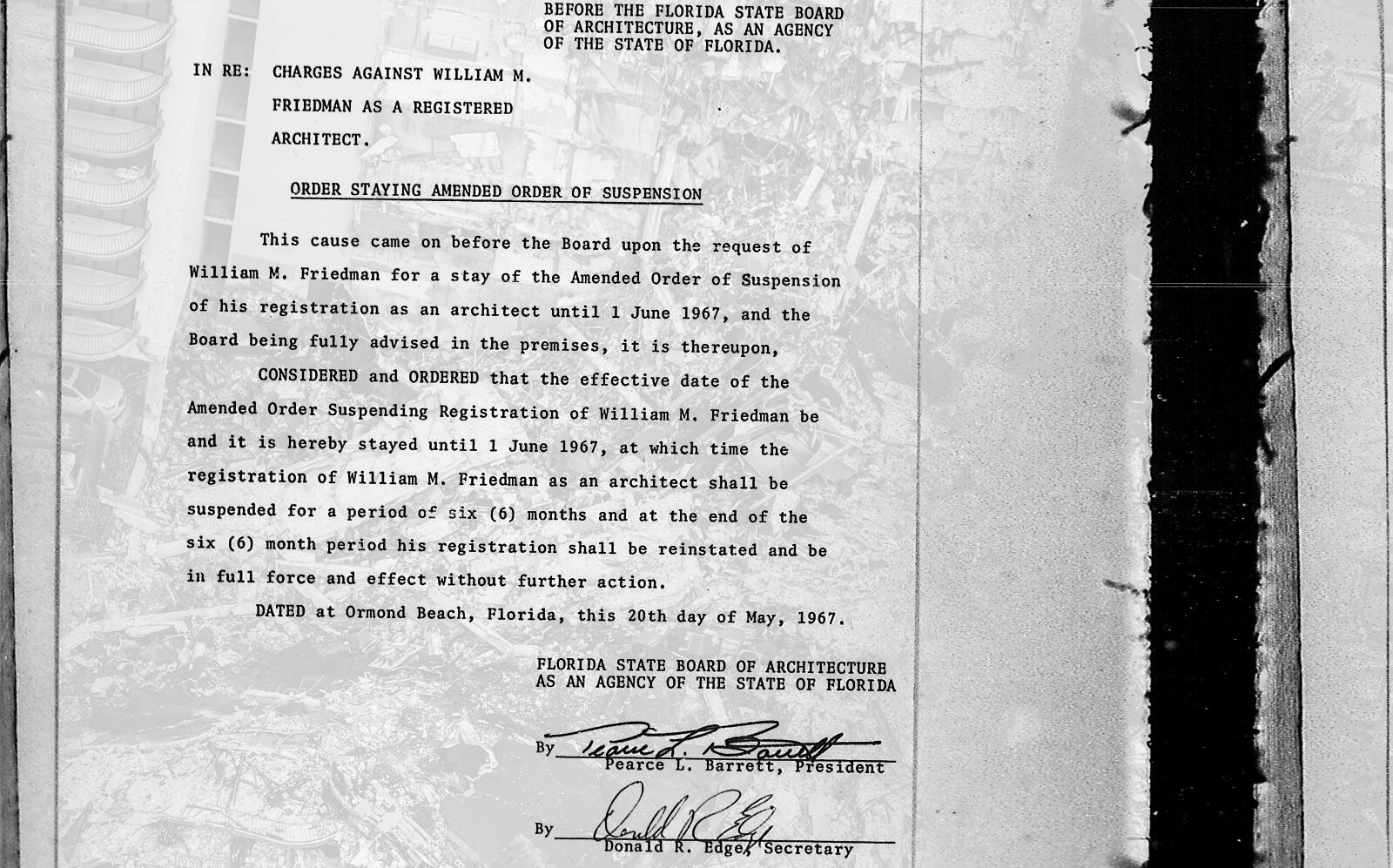More than a decade before William Friedman designed the collapsed Surfside condominium, Florida’s board of architecture suspended him for six months for designing structures that toppled during Hurricane Betsy.
Sign pylons that were “an integral part of the structure” of a Miami commercial building failed during the 1965 storm, according to documents from the Florida State Board of Architecture, obtained by The Real Deal.
The pylons were “insufficient and grossly inadequate” to withstand the wind pressure of the hurricane force winds, and were not in accordance with building code for the location or “to accepted standards of architectural practice,” the Florida Board of Architecture wrote in its order suspending Friedman.
In 1966, the five-member architecture board found Friedman in violation of Florida law and guilty of “gross incompetency, in that he negligently, improperly, and carelessly” designed the pylons. Friedman’s suspension started on June 1, 1967 and ended on December 1, 1967.
The details of Friedman’s suspension were revealed after a public records request filed by TRD.
The revelations add to the list of controversies tied to the development team of the Champlain Towers South. So far, there is no evidence that any of the original development team, including the developer, the architect or the engineer, played a role in the collapse.
Still, the findings could provide another element for investigators as they try to piece together the cause of the collapse of Champlain Towers South that killed 97 people.
Read more

At least one indicator of a “major error” has so far been discovered in the original project plan prepared by Friedman and the project engineer, according to a 2018 engineer’s report on the 12-story condo. The inspection found that a concrete slab at a part of the building was not sloped for water to drain.
Surfside Condo That Collapsed Had Major Structural Damage
“The question comes down to: Was it a design error or deferred maintenance that was the approximate cause for the collapse?” said Frank Schnidman, a retired urban planning professor at Florida Atlantic University in Boca Raton.
“A drafting error”
The collapsed pylons came after Friedman had practiced architecture for about a decade, documents show. Licensed in 1955, Friedman led the eponymous Coral Gables-based firm William M. Friedman & Associates Architects. He died in 2018 at 88.
On Sept. 16, 1965, a week after Hurricane Betsy tore through the area, the director of Miami’s building department reported the pylon issue to the board of architecture.
Robert Ferencik’s letter to the board noted that a building under construction at 2625 Southwest 22nd Street included a sign pylon about 20 feet above the roof line. The sign pylon had failed at the roof line and “collapsed along side of the building.” The director also found that a single-story commercial building, recently constructed at 7001 Southwest 88th Street, also had a sign pylon failure.
It is unclear from the documents if the sign pylons were attached to the building or next to it. Schnidman, who reviewed the records at TRD’s request, said it seems the pylons were attached.
Fort Lauderdale architect Kaizer Talib told TRD the description of the sign pylon sounds like it was a promotional sign perched atop the building’s roof.
A 20-foot pylon is not a simple design, added Talib, owner of Kaizer Design Group. “It means that where the roof is, this pylon was going up and broke down from the slab, so the connection may have been poorly” done, he said.
The collapse was also serious enough for at least one prominent Miami architect to alert the Florida State Board of Architecture.
Edward Grafton, a principal at Pancoast, Ferendino, Grafton, Skeels and Burnham, asked the board to “give serious consideration” to the structural failures caused by Friedman’s design.
“This matter has, and will, receive the consideration of one of the newspapers and various citizens,” Grafton wrote in his letter dated Sept. 21, 1965.
The board found Friedman guilty of two charges in May 1966, with concurrent sentences of six months. Friedman appealed to the Florida District Courts of Appeal, which overturned the second charge. He then appealed the remaining charge to the Florida Supreme Court, but was unsuccessful.
Friedman’s lawyer, Harry Smith of Miami Beach, also tried to persuade the board to reduce the architect’s sentence, but again, he was unsuccessful. He claimed the punishment was “tantamount to nearly a complete destruction of his name and reputation, as well as his architectural practice.”
Smith added that there was no “premeditated design” aimed at creating harm “to any person or persons.”
Instead, he called the design flaw a “drafting error.”
A Serious Offense
Talib, the Fort Lauderdale architect, called a suspension a “serious thing.”
“Most of the time you end up getting a letter of warning from the state department or something,” he said. “If you had done something small wrong, in the process of permitting, then you might get a warning letter. But a suspension is a bigger thing because it’s decided by a committee. It’s not decided by an individual.”
Still, suspensions carry few real world consequences, industry experts say.
“Some people know about [the suspension], but the general public doesn’t know,” Talib said. An architect “just keeps quiet and he is not going to tell anyone except his wife.”
Schnidman said that although records show Friedman’s pylons designs were “inadequate,” the onus still falls on the jurisdictions that approved the plans.
“You have to wonder about the level of local government review, because if in fact these did not comply with the regulations at the local level, how did it get past inspection?” he said.
Records reveal that the pylon issue was not the first time Friedman faced questions from the state’s architecture board. It also received “certain information concerning alleged plan stamping” by Friedman, according to records provided to TRD. But they do not indicate how this claim unfolded, nor do they provide specifics on the allegation.
Talib said plan stamping is an illegal practice in which a licensed architect stamps plans and drawings created by someone else, often someone who does not have a license or is not an architect. This is “very unethical and very illegal,” Talib said. “That is the worst an architect could do.”
He said the custom was common in the past, but oversight has increased, and it is less common now. He said architects who do it should have their licenses revoked.
None of these allegations seemed to have impacted Friedman’s career. His obituary described him as a “very unique architect” who designed many “unusual properties” in Miami including a hospital, shopping center, apartments, townhouses and residences.
Among those properties was Champlain Towers South, developed by Nathan Reiber. When it was built in 1981, it marked one of the largest condo projects in Surfside’s history.
Talib said developers generally do not dig deep into an architect’s background, since they are not familiar with the suspension process. He imagines that was the case for Friedman in Surfside.
“As long as the developer and clients like him,” he said, “then he could get hired again.”
